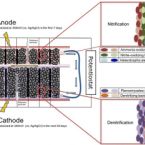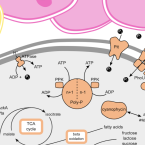Publications
Publications in peer reviewed journals
Enhanced nitrogen and carbon removal in natural seawater by electrochemical enrichment in a bioelectrochemical reactor
2022 - J Environ Manage, 323: 116294
Abstract:
Municipal and industrial wastewater discharges in coastal and marine environments are of major concern due to their high carbon and nitrogen loads and the resulted phenomenon of eutrophication. Bioelectrochemical reactors (BERs) for simultaneous nitrogen and carbon removal have gained attention owing to their cost efficiency and versatility, as well as the possibility of electrochemical enrich specific groups. This study presented a scalable two-chamber BERs using graphite granules as electrode material. BERs were inoculated and operated for 37 days using natural seawater with high concentrations of ammonium and acetate. The BERs demonstrated a maximum current density of 0.9 A m−3 and removal rates of 7.5 mg NH4+-N L−1 d−1 and 99.5 mg L−1 d−1 for total organic carbon (TOC). Removals observed for NH4+-N and TOC were 96.2% and 68.7%, respectively. The results of nutrient removal (i.e., ammonium, nitrate, nitrite and TOC) and microbial characterization (i.e., next-generation sequencing of the 16S rRNA gene and fluorescence in situ hybridization) showed that BERs operated with a poised cathode at −260 mV (vs. Ag/AgCl) significantly enriched nitrifying microorganisms in the anode and denitrifying microorganisms and planctomycetes in the cathode. Interestingly, the electrochemical enrichment did not increase the total number of microorganisms in the formed biofilms but controlled their composition. Thus, this work shows the first successful attempt to electrochemically enrich marine nitrifying and denitrifying microorganisms and presents a technique to accelerate the start-up process of BERs to remove dissolved inorganic nitrogen and total organic carbon from seawater.
The novel genus, 'Candidatus Phosphoribacter', previously identified as Tetrasphaera, is the dominant polyphosphate accumulating lineage in EBPR wastewater treatment plants worldwide.
2022 - ISME J, 6: 1605-1616
Abstract:
The bacterial genus Tetrasphaera encompasses abundant polyphosphate accumulating organisms (PAOs) that are responsible for enhanced biological phosphorus removal (EBPR) in wastewater treatment plants. Recent analyses of genomes from pure cultures revealed that 16S rRNA genes cannot resolve the lineage, and that Tetrasphaera spp. are from several different genera within the Dermatophilaceae. Here, we examine 14 recently recovered high-quality metagenome-assembled genomes from wastewater treatment plants containing full-length 16S rRNA genes identified as Tetrasphaera, 11 of which belong to the uncultured Tetrasphaera clade 3. We find that this clade represents two distinct genera, named here Ca. Phosphoribacter and Ca. Lutibacillus, and reveal that the widely used model organism Tetrasphaera elongata is less relevant for physiological predictions of this uncultured group. Ca. Phosphoribacter incorporates species diversity unresolved at the 16S rRNA gene level, with the two most abundant and often co-occurring species encoding identical V1-V3 16S rRNA gene amplicon sequence variants but different metabolic capabilities, and possibly, niches. Both Ca. P. hodrii and Ca. P. baldrii were visualised using fluorescence in situ hybridisation (FISH), and PAO capabilities were confirmed with FISH-Raman microspectroscopy and phosphate cycling experiments. Ca. Phosphoribacter represents the most abundant former Tetrasphaera lineage and PAO in EPBR systems in Denmark and globally.



